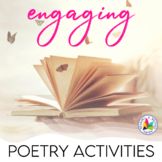Mood and Tone Activity for Any Fictional Text - Digital and Print
- PDF
- Google Apps™

What educators are saying
Also included in
- Looking for poetry activities that gives you the flexibility to be creative with your lesson planning? The resources in this bundle are designed to allow you to do just that! You'll find opportunities for students to analyze poems, write poems, and play games about poetic elements.The best part abouPrice $25.97Original Price $33.91Save $7.94
Description
Looking for a fun and creative way to help students analyze mood and tone in a fictional text? Try using a sound equalizer metaphor to help students understand how mood and tone can fluctuate throughout a text, but they work in tandem to shape the overall piece. This mood and tone activity is sure to elevate thinking!
This mood and tone activity is intended to provide students with a critical thinking challenge. If you intend to use it with struggling readers, I suggest taking time to model and guide them through the activity at least once.
A video tutorial IS included to walk students through how to complete the tech-y aspects of the assignment. The video tutorial is intended to help answer some of the questions students may have when completing this activity remotely.
THIS RESOURCE CAN BE USED FOR DISTANCE LEARNING.
DIGITAL AND TRADITIONAL PDF VERSIONS ARE INCLUDED!
Here is how the mood and tone activity works...
1. Students read a fictional text. Any text is fine, but it should be long enough to be able to identify six different parts.
2. For each part of the text, students identify fitting mood and tone words. Sample mood and tone lists are included. Students also choose a color to symbolize the mood of that part and color in the graphic organizer to a height that matches the tone of the section. In this way, students are thinking symbolically about both mood and tone.
3. After filling out the graphic organizer, students write short justifications of their choices, and they also identify textual evidence that supports the mood and tone words they selected.
4. You also have the option of asking students to respond to four questions that extend their thinking. These questions involve synthesizing what they have already mentioned for each different part of the text. The questions lead students to explain how tone and mood impact other aspects of the story.
5. Finally, you'll also have access to tone and mood bookmarks that you can use as exit slips or quick formative assessments. They will give you data regarding who needs further scaffolding or small group re-teaching. A second version of these bookmarks is included that is better formatted for distance learning.
To help you and your students better picture how to use this activity, this resource includes sample responses for the poem "The Highwayman" by Alfred Noyes.
I created this mood and tone activity as I reflected upon how I think about these literary terms. They can be difficult for students, but bringing in metaphors and scaffolding their thinking step-by-step can set them up for success. Surprising students with new and unique activities can help keep boredom at bay and spark curiosity and engagement.
Please Note: This activity is intended for practice, not introduction. The resource does not include direct instruction for mood and tone. Please make sure your students have already been introduced to these concepts before using this assignment with them.
Loving this? You may enjoy these similar resources:
Analytical Short Story Activities
Find more reading activities here!
Stay in touch:
~~~~~~~~~~~~~~~~~~~~~~~~~~~~~~~~~~~~~~~~~~~~~~~~~~~~~~~~~~
A Couple Tips:
* Be sure to click the "follow" button that is located next to my picture so that you can hear about sales and new products!
* By providing feedback on your purchased products, you can earn points, which ultimately translate into cash toward future purchases...bonus! Plus, I'd love to hear from you.
©Reading & Writing Haven
All rights reserved by author.
Duplication limited to single classroom use only.
Electronic distribution limited to single classroom use only.






